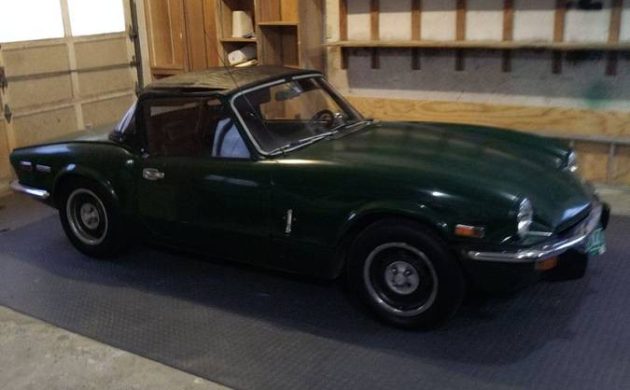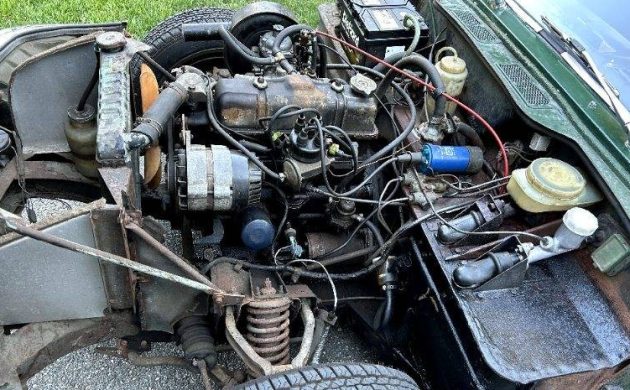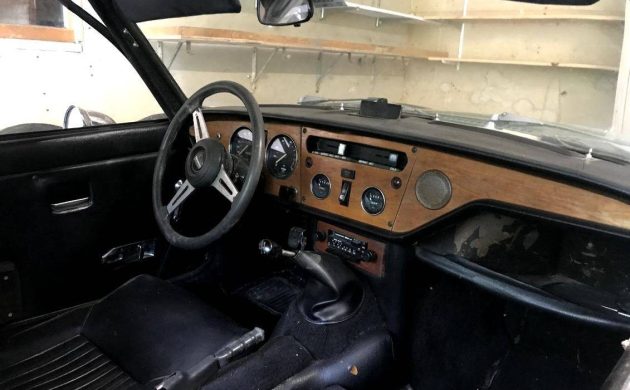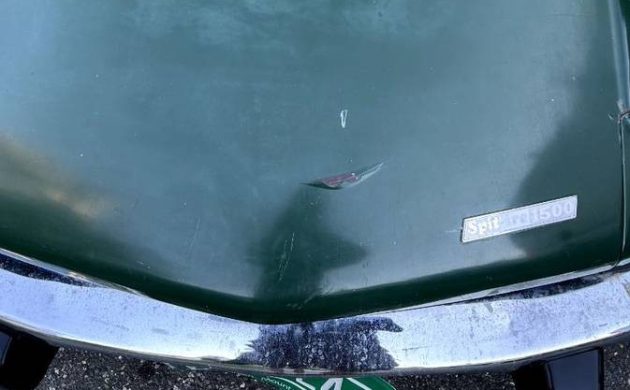This Spitfire is for sale because the owner found a prettier prospect – as he puts it, “something newer and shinier caught my eye.” Since the car was purchased for Spring driving, we can surmise that the seller hasn’t had his Spitfire for long. It’s advertised here on craigslist, reduced to $3000 after a potential buyer found surface rust on the underside. It runs well so it might complete the trip to its new garage from Norwich, Virginia. This Spitfire is from the next to last generation of a model that was introduced in 1962. Michelotti – who we can think of as Triumph’s go-to designer – dished up a nice roadster all the way back in 1960, but that poor car sat in a corner at Canley until executives from Leyland noticed it under a dust sheet. They liked it. With the Austin Healey Sprite capturing market share in the “cheap sports car” category, commercialization of the “Bomb” was approved in 1961. Thanks to Mitchell G for the tip!
The Spitfire was powered by a successively larger engines over its production span, beginning with a tiny but adequate 1147 cc four-cylinder. By the 1970s, emissions controls were creeping into the US regulatory framework. Engine shenanigans ensued – British cars retained a 1296 cc dual carb’d motor, but in the US, that engine came with a lower compression ratio and a single Zenith. The performance demerit worsened from there: by ’73, despite a displacement increase to 1493 ccs, the carburetor count remained stingy at one and the compression ratio declined again, pushing output down to about 53 hp. Travesty. At least the tuck-in swing axle arrangement in the tail was ameliorated. Looks like someone may have replaced the master cylinders and repainted that shelf; the whole engine bay should be body color.
The interior was redesigned with a full-width wood dash and gauges set in front of the driver rather than clustered in a pod above the transmission tunnel. The four-speed manual gearbox was fully synchro’d. This cabin is showing its share of wear, but what we’re shown is tolerable, with all the trim present. The sun visors are shown in the down position – sometimes those are reluctant to remain up. No mention is made of the condition of the top. An aftermarket stereo is installed beneath the dash.
The front bumper should have two over riders (similarly, so should the rear); this bumper is not straight and the nose has been dented – a common condition. The paint displays oxidation, but we already know this car’s price is too low for us to expect a car with no needs. Is it low enough? If the car drives out nicely, it could make a fun summer sport-about, but if you’re shopping for a restoration project, mind your pennies and aim for the prettier earlier models, where the market pays a premium price.






This is 100% a good deal all around. The seller has a fair price, the car seems to be in decent condition, But for the distance between me and that car, I’d be all over it.
I’m a big fan of Spitfires. currently own two. They sometimes suffer from snobbery in the classic car sphere, being small, cheap and mass-produced, but I feel that they are one of the best fun-for-your-money equations out there. Parts supply and aftermarket support is excellent, and they are about the easiest classic car I can think of to work on with simple mechanicals and the flip front giving perfect accessibility.
This one seems reasonable value. it is a little grungy under the hood but seems fairly complete and original. The true state of the bodywork would be the big question. As noted by the author, the firewall deck has been painted over which is not necessarily a good sign. The battery tray often rusts out on these cars due to the battery acidity/chemicals but can be replaced in isolation, quite easily.
This one does not have overdrive either, which is a slight negative (though few US market cars seemed to have it from new)
Unfortunately, Spitfires fall into that trap for cheaper classics, that it’s not worth it economically spending a fortune on full restoration because the finished car will never sell for big money, as often quoted on this site “better to buy the best one you can find” than take a rough one and try and bring it up to standard – unless you just want the fun and experience of the restoration project.
Also, the UK and rest-of-world Spitfires retained full power right until the end of production – 71 bhp. It is quite easy with a few mods to upgrade the performance of the tepid federal spec car to UK spec or more. Both my Spitfires are built up that way with raised compression, head work, Mk III profile cam and UK twin SU carbs and somewhere in region of 90 bhp. You’re still not going to scare anyone at the traffic-light drag races but they are lot of fun to drive with a little more power.
In the early ’70’s, I worked in a dealership that sold Triumphs. I discovered that Triumph had a full range of competition parts available for those who chose to void their waranty and go racing. The warrantees are no longer of concern. Triumph may still support these engines.
Boy, sure took that one apart Michelle. Interesting comment on the visors. Since our weather is mostly sunshine our visors rarely come up to the “up” position except to clean the inside of the windshield. ClassicCarFan said it all about this one.
I’m sensitive to the sun visor issue because I just looked at a second-generation Capri with a 2.8L V6 (nice!) and the dang sun visors wouldn’t stay up. Otherwise, I might not have noticed that on this Triumph.
Rented a Capri in Europe while waiting for our car to arrive. As you said, Nice!
Had the ‘74 version of this while working/going to college, same color but with the electric OD switch on top of the hollow shifter. Road trip with a friend from Reno to Jerome,ID. Leaked at the top leading edge of the convertible top during a rain squall outside of Winnemucca, laughed about it being the only car to have a built in shower feature..
Can’t see one of these and not smile. Sports car good times defined.
Had one in college. Spontaneous road trip with my girlfriend out the Devilsbackbone in central Texas, Friday after classes.
Good times, good times
Best smiles per dollar out there even today.
Great write up!
In 77 and 79 I bought both new Spitfires with the 79 having a factory hardtop and overdrive transmission. These the coolest and very dependable of the late British Laylen cars. For 3000.00 this is a steel. I drove my Spitfire long distant around the east cost with no problems at all. Being young again with a British convertible back in the Seventies was the best of times. You all take care.
In 77 and 79 I bought both new Spitfires with the 79 having a factory hardtop and overdrive transmission. These the coolest and very dependable of the late British Laylen cars. For 3000.00 this is a steel. I drove my Spitfire long distant around the east cost with no problems at all. Being young again with a British convertible back in the Seventies was the best of times. You all take care.
My brother had an earlier version and had fun turning it on a dime! These could turn around from one lane to the next! (But it scrubbed the front tires so much that he had to get new ones often.)
Nice looking, good price. I have a 1970 MG, certain things are easy to fix, other things are a pain in the arse. Try changing the oil/temp gauge on the dash… Or, bleeding the brakes/clutch… Need a new clutch? Pull the engine…
No need to pull the engine to service the clutch.
The transmission could be pulled from the inside.
Not on my MG, which is a 72… Go online if you don’t believe me…
On the BMC cars you pull the engines but not Triumphs. Besides the clutch we changed all the engine bearings with the engine in the car on my stepson’s Spitfire.Triumph made all their cars easy to work on up to the 7.
In 1971, I was working for a small independent repair shop. A Mk1 (“”Bug-Eye”) Sprite came into our shop. He had just had the clutch replaced in another shop. The “mechanic” had decided that the easy way to do the job was with an air chisel, removing the floor above the transmiison.. These have a unibody construction, and, in our opinion, he had totalled the car. We suggested the owner contact the state motor vehicle inspectors and his attorney.
Seller says in his ad a fellow crawled under it Noone ever crawled under a Spitfire not on a lift A squirrel could not fit under one